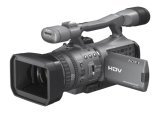 I wonder why some video houses still produce videos on analog Betacam-SP. They should stop wasting clients money and make videos in High Definition or HD.
I wonder why some video houses still produce videos on analog Betacam-SP. They should stop wasting clients money and make videos in High Definition or HD. We all know clients cannot play and watch a video recorded in Betacam-SP. We do know all of us can easily play DVD, mini-DV and the up-and-coming HDV.
We all know clients cannot play and watch a video recorded in Betacam-SP. We do know all of us can easily play DVD, mini-DV and the up-and-coming HDV.In today's tutorial, I will go through the process of transfering Betacam-SP to mini-DV. I do this frequently for clients, so that they can watch their videos while preserving high quality.
using
Sony Betacam SP Player
and
Sony MiniDV CamCorder
- Connect the Betacam Player XLR audio outputs to the MiniDV Camcorder Line audio inputs using the cable provided with the camcorder and a pair of XLR adaptors.
- Connect the Betacam Player s-video output to the MiniDV Camcorder s-video input using an s-video cable.
- Power up the units.
- Set the MiniDV Camcorder to VTR mode, AV in.
- Insert a blank MniDV tape into the MiniDV Camcorder.
- Insert the Betacam SP tape into the Betacam Player.
- Play the Betacam and start recording on the MiniDV Camcorder.
End




Hi Adrian. Nobody's money is being wasted if they orginate on Betacam SP. Betacam Sp is a terrific archival format and is much easier to playback then trying to decipher the FIFTY PLUS HD formats that currently exist, with more on the way!
ReplyDeleteFor consumer videos, acquiring on miniDV or HDV is definitely of no issue. However, when it comes to broadcast or professional applications, Betacam SP despite being an analog format that is existing for over 20 years, it is still one of the best analog video formats available.
ReplyDeleteBetacam SP footage can be digitised at 8bit Uncompressed 4:2:2 video whereas miniDV are compressed at 4:2:0 resolution. This can mean a lot of difference in post production applications like color grading & chroma key effects shot.
Betacam SP is definitely a more robust format and like what Alessandro mentioned, it's a terrific archival format.
In most post production applications for broadcast, use of timecode is also very important and miniDV lacks such critical feature.